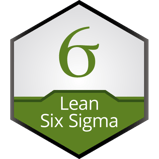 Do you have waste in your organization? Does your organization do things that seem inefficient? If you answered yes to either of these questions, you might want to consider Lean. If you answered no, you are in denial! We all have processes and procedures that are inefficient. Processes and procedures tend to grow over time with items added on to address changing business needs or special cases. At some point, the process has grown so huge that two things occur: (1) It becomes very fragile, such that small changes tend to break it or (2) it is so very intensive that the resources it requires outweigh the benefits it provides.
Do you have waste in your organization? Does your organization do things that seem inefficient? If you answered yes to either of these questions, you might want to consider Lean. If you answered no, you are in denial! We all have processes and procedures that are inefficient. Processes and procedures tend to grow over time with items added on to address changing business needs or special cases. At some point, the process has grown so huge that two things occur: (1) It becomes very fragile, such that small changes tend to break it or (2) it is so very intensive that the resources it requires outweigh the benefits it provides.
To determine if you suffer from excessive process and should consider investigating Lean, I would recommend you ask yourself the following questions: As a business, what are we doing that is less productive? How can we eliminate inefficiencies and implement change to address a problem? How do we know if the change made a difference? Will that difference bring value to our clients? These four questions are the key to making meaningful changes and getting rid of entropy and waste in an organization. This is how you introduce Lean principles into your organization. Cimetrix began introducing Lean last year: Here is our story.
David Warren, Director of Software Engineering, initially introduced the concept of Lean software development through a book club he started for the Engineering group. David’s book club read the book Implementing Lean Software Development, From Concept to Cash by Mary and Tom Poppendieck. The book provides insight into the seven lean principles as they apply to software development. The timing our study of the the Lean concept coincided with the Cimetrix All Company Gathering. David proposed doing a value-stream map of one of our key processes as an exercise for the entire company as one of our large group activities. To ensure the success of the activity, David found a local consulting company that is proficient in Lean to conduct a hands-on workshop for the All Company Gathering activity.
Our first workshop in Lean was conducted by Alan Davis of Promontory Management Group. The initial four-hour workshop focused on generating an as-is map of our process for handling our Software Change Requests (SCR). The process involved identifying each of the steps currently used for addressing an SCR as well as the time lapse for each step. Every member of Cimetrix was involved in identifying the steps involved. At the end of our workshop, there was a great desire by all involved to look at the next step of how to identify our pain points and look for areas to improve our processes.
The interest by all our employees was great enough that we changed the schedule for the following mornings activities to continue with a follow-on workshop. During that workshop, we identified several pain points that could be addressed. The top five were identified, by consensus of all involved. Alan Weber put together a proposal for training a group of Cimetrix employees in the process of Lean Six Sigma using the five identified pain points for hands on training. The Round Table, our leadership team, felt there would be value in moving forward with implementing lean processes in Cimetrix.
The employees who would be trained in the Lean Six Sigma process, and be responsible for the projects, were taken on a volunteer basis. Nine people volunteered for the training. I was one of the volunteers and was assigned to be the facilitator for the overall Lean Six Sigma training. The training occurred over the course of the next five months for the volunteers. This was done in addition to each members’ regular work requirements. The training focused on the principles of Lean. Terms such as DMAIC, 5-whys, baseline metrics, and ROI were not just studied, they were put into practice by the project leads. Each project lead put together a team consisting of Cimetrix employees to tackle their assigned project.
Each project lead was awarded a Lean Six Sigma Green Belt certification at the conclusion of their training. A celebration was held to present the awards to each of the project leads. I would like to congratulate:
- David Warren
- Brian Rubow
- Tami Traci
- Brent Forsgren
- Jake Strong
- Mohammad Islam
- Jesse Wright
- Kim Daich
Each project lead did an outstanding job both as a participant and as a team leader in this process. They took on the responsibility of learning, leadership and project execution in a manner that is true to the core values of Cimetrix.





